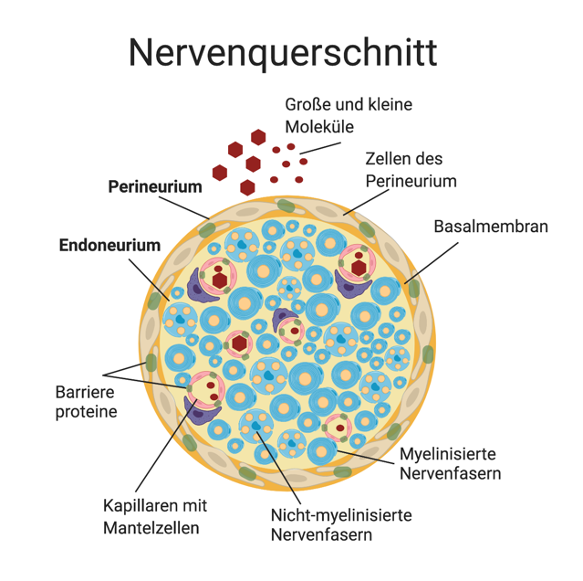
Blood-nerve barrier

The blood-nerve barrier protects the peripheral nerve, which is responsible for the electrical transmission of signals such as body sensation or movement, against damaging external influences. The blood-nerve barrier consists of two cell layers, the cell envelope and the basement membrane, as well as the capillaries within the nerve. If this barrier is damaged, it becomes permeable and abolishes the selective passage of substances. This also has negative effects on the electrical transmission of nerve signals.
Research Objective
Project 7 investigates the restoration of the blood-nerve barrier at the cellular and molecular level, in parallel with pain resolution after nerve damage under the influence of endogenous netrin. Netrin is a growth factor that controls the growth direction of neurons during embryonic development. Recent results indicate that netrin also stabilizes the blood-nerve barrier in the body after the maturation of the nervous system is complete.
Procedure
To this end, we use preclinical models of nerve damage, based on which we observe the action and function of netrin. The preclinical models used are (1) Chronic Constriction Injury, in which the nerve is ligated, and (2) polyneuropathy triggered by the chemotherapeutic agent bortezomib. Project 7 is also making these disease models available to other project groups in KFO 5001.
In the translational part of the project, we analyse skin samples with the processes of the nerves as well as the sera of patients with complex regional pain syndrome and neurofibromatosis for barrier proteins and netrins.
Modern techniques
In skin and tissue samples, we are establishing high-resolution microscopiy techniques to measure barrier function for different molecule sizes. In cooperation with the Clinical Physiology at the Charité Berlin, special techniques can be used to generate in vitro models for detailed characterization of nerve barriers, analyse electrophysiological properties, measure molecule passage, and quantify tight junction protein expression - changes in barrier-determining molecules. In addition, a barrier resolution model is also planned to represent the molecular changes in the blood-nerve barrier upon barrier sealing, which occurs in parallel with pain resolution.
Significance for patients
Other medical specialties are already investigating drugs that support growth factors. It is also possible that netrins could be used as agents to treat nerve pain by promoting pain resolution through barrier sealing.
Research Team P7
Leader
PD. Dr. rer. nat. Susanne Krug
Research Group Leader Institute of Physiology and Nutritional Medicine
Charité – University Medicine Berlin
Campus Benjamin Franklin
Univ.-Prof. Dr. Heike Rittner, MD
Scientific Coordinator of KFO5001
Head of the Centre for Interdisciplinary Pain Medicine (ZiS)
Members of the team
Dr. rer. nat. Jeremy Chen, Researcher
Lukas Knobe, Charité – University Medicine Berlin
Selected Publications
Reinhold AK, Yang S, Chen JT, Hu L, Sauer RS, Krug SM, Mambretti EM, Fromm M, Brack A, Rittner HL (2019)
Tissue plasminogen activator and neuropathy open the blood-nerve barrier with upregulation of microRNA-155-5p in male rats.
Biochim Biophys Acta Mol Basis Dis. 2019 Jun 1; 1865(6):1160-1169.
Go to publication
Krug SM, Fromm M (2019)
Special Issue on "The Tight Junction and Its Proteins: More than Just a Barrier"
Int J Mol Sci. 2020 Jun 29;21(13):4612.
Go to publication
Krug SM, Amasheh M, Dittmann I, Christoffel I, Fromm M, Amasheh S (2013)
Sodium caprate as an enhancer of macromolecule permeation across tricellular tight junctions of intestinal cells.
Biomaterials 2013 Jan;34(1):275-82.
Go to publication
Hackel D, Krug SM, Sauer RS, Mousa SA, Böcker A, Pflücke D, Wrede EJ, Kistner K, Hoffmann T, Niedermirtl B, Sommer C, Bloch L, Huber O, Blasig IE, Amasheh S, Reeh PW, Fromm M, Brack A, Rittner HL (2012)
Transient opening of the perineurial barrier for analgesic drug delivery.
Proc Natl Acad Sci U S A. 2012 Jul 17; 109 (29):E2018-27.
Go to publication


